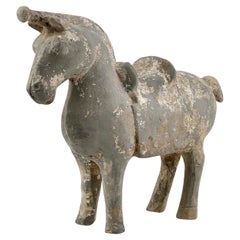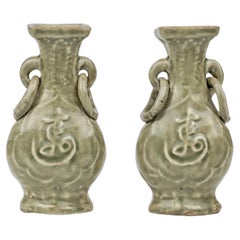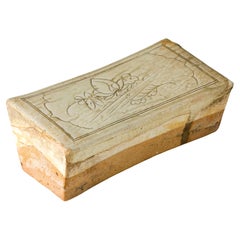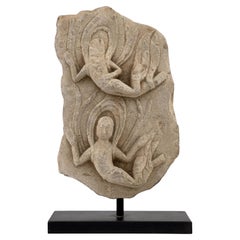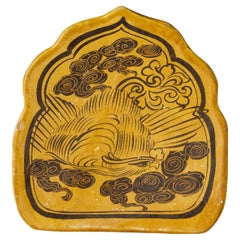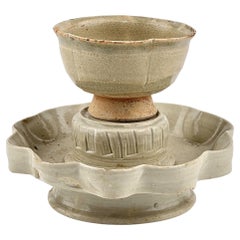Hong Kong Antiquities
to
148
3
1
157
1
147
6
4
3
1
1
146
61
24
24
19
6,542
1,873
1,329
729
398
157
157
157
1
Place of Origin: Hong Kong
Figure of a Horse with traces of white slip, Western Jin-Han Dynasty
Located in seoul, KR
A standing horse, back legs slightly apart and bent, tail erect, wearing a saddle with saddlecloth, and with bridal ornaments on forelock. This horse represents a breed from the Mong...
Category
15th Century and Earlier Han Antique Hong Kong Antiquities
Materials
Pottery
$4,550 Sale Price
35% Off
Two Set of Molded Longquan Celadon 'Fu Shou' Vases, Ming Dynasty
Located in seoul, KR
One side of the vase showcases a panel with the Shou character at its center, symbolizing longevity, while the opposite side displays the Fu character, signifying luck. The neck of the vase is adorned with leaves.
Period: Yuan-Ming Dynasty (1271-1644)
Region: Longquan, China
Medium: Celadon
Type: Ewer
Provenance : Acquired in late 1990s from Hongkong
Reference
1) British Museum - Museum number 1931,1118.5
(Type : Closely related)
2) Christies NEW YORK 24–25 MAR 2022 - Important Chinese Ceramics and Works of Art - Lot 1105
(Price realised : 9,450 USD / Type : Related)
3) Sotheby's New York 19 March 2024 - Chinese Art - Lot 172
(Price range : 15,000 USD - 20,000 USD / Type : Related)
* Ming Dynasty Longquan Celadon
Longquan celadon from the Ming Dynasty typically exhibits a more robust and heavier stoneware body compared to its Song Dynasty predecessors. The Ming era saw an evolution in celadon glaze, achieving a wider spectrum of green hues, from olive to bluish-greens. Ming celadons...
Category
15th Century and Earlier Ming Antique Hong Kong Antiquities
Materials
Celadon
$3,893 Sale Price
35% Off
Cizhou Rectangular Pillow with Carved Decoration, Yuan Dynasty
Located in seoul, KR
Cizhou ware is known for its robust forms and freely applied decoration, often featuring a white slip under clear glaze. The pillow is rectangular, with a slightly curved top surface to accommodate the head of the sleeper. The decoration on this pillow features an incised design, delineated with fine lines to create a clear and simplistic representation. The motif includes floral elements, likely peony or chrysanthemum, and foliage, which were popular during the Song and Yuan periods. The carving is subtle yet skillful, showing the artistry and aesthetic preferences of the era.
Period : Yuan Dynasty, 13th-14th Century
Type : Pillow
Medium : Cizhou Ware
Provenance : Acquired in late 1990s from Hongkong
Reference :
1) Datong Museum - Cizhou Pillow...
Category
15th Century and Earlier Antique Hong Kong Antiquities
Materials
Pottery, Stoneware
$2,535 Sale Price
35% Off
Heavenly Beings Carved Limestone Stele Fragment, Northern/Eastern Wei Dynasty
Located in seoul, KR
Flying two heavenly beings depicted in the stone. They are celestial beings called an Apsara. While having the same fragment and shape, another work I uploaded exhibits small dots on...
Category
15th Century and Earlier Han Antique Hong Kong Antiquities
Materials
Limestone
$6,435 Sale Price
35% Off
Rare Cizhou 'Mandarin duck and Reishi mushroom' Painted Pillow, Jin-Song Dynasty
Located in seoul, KR
Mandarin ducks symbolize eternal love and fidelity in East Asian culture, often representing marital harmony as they are believed to mate for life. Reishi mushrooms, known as symbols of longevity and health, are revered in traditional Asian medicine for their association with immortality and have been used for centuries to promote vitality and strengthen the immune system.
The orange glaze is commonly found on Cizhou-type tiger pillows. The attached materials indicate that this tiger pillow is from the same period and shares the same color tone as the one housed in the Baoji Bronzeware Museum, a national museum located in Shaanxi Province. Considering the glaze color, painting style, and shape, it is speculated that this piece was used by the imperial court.
Period : Jin-Song Dynasty(12-13th century)
Type : Pillow
Medium : Cizhou Ware
Size : 28 cm(Width), 30cm(Vertical), 16cm(Height)
Provenance : Acquired in late 1990s from Hongkong
Reference
1) Christies Hongkong 9 OCT 2019 - The Pavilion Sale - Chinese Ceramics and Works of Art Including the Quek Kiok Lee Collection
(Price realised : HKD 225,000 / Type : related)
2) The Baoji Bronzeware Museum, Shaanxi Province - Tiger Cizhou Pillow...
Category
15th Century and Earlier Antique Hong Kong Antiquities
Materials
Pottery
$10,680 Sale Price
40% Off
Stem Cup and Stand, Song Dynasty(960~1279)
Located in seoul, KR
Five-lobed cup, featuring a delicate rim, is supported by a short, gently spreading foot. The accompanying stand rises elegantly from a broad base to a plate with an elevated, foliat...
Category
15th Century and Earlier Antique Hong Kong Antiquities
Materials
Ceramic
$2,495 Sale Price
50% Off
Changsha ewer, Tang Dynasty(618-907)
Located in seoul, KR
Changsha Ware has distinct and recognizable designs and motifs. Painted designs often depict flowers, vines, clouds and mountain landscapes. Some painting is simply splotches of colo...
Category
15th Century and Earlier Tang Antique Hong Kong Antiquities
Materials
Stoneware
$3,196 Sale Price
60% Off
Cizhou carved bean-shaped pillow, Song-Jin Dynasty, 11th-12th century
Located in seoul, KR
Crafted from fine clay, the pillow's surface boasts a sophisticated carved design featuring a floral motif that is both symmetrical and organic. The interplay of the earthy tones and...
Category
15th Century and Earlier Chinoiserie Antique Hong Kong Antiquities
Materials
Stoneware
$2,535 Sale Price
35% Off
A Rare Yue Celadon-Glazed Figural Vessel, Western Jin dynasty (265-420)
Located in seoul, KR
This vessel is well-modeled as a recumbent winged lion with detailed decorative elements. It features a grimacing face with large protruberant eyes under heavy brows and a gaping mouth, which forms a large aperture. The piece has a tail that arches to form a loop handle, and the wings are incised on the sides. The whole piece is finished with a thin olive-green glaze.
This kind of figural vessel dates back to at least the Western Han dynasty, with the design fully developed in the Yue kilns of Zhejiang province during the 3rd and 4th centuries. Such zoomorphic forms became popular among the literati and were transformed into various functional objects like wine ewers and water pots.
There is a pair, and you can check it in the uploaded list. If you would like to purchase two in pairs, please leave a message.
Period : Western Jin Dynasty (266 - 316 AD)
Type : Figural vessel
Medium : Yue celadon(Stoneware)
Provenance : The piece was acquired in Hong Kong in late 1990s.
Reference :
1) Sotheby's New York 17 March 2015 - Chinese Art Through The Eye Of Sakamoto Gorō – Ceramics Lot 33
(Price Range : 15,000 USD-20,000 USD / Type : Highly related)
2) Sotheby's London 17 May 2023 - A Journey Through China's History. The Dr Wou Kiuan Collection Online. Part I - Lot 30
(Price realised : 13,970 GBP / Type : Closely related)
3) Ethnological Museum, Berlin, Germany - Pouring vessel in animal shape, China, Yue kilns, Zhejiang province, late Western or early Eastern Jin dynasty, 4th century
4) Sotheby's London 16 May 2018 - Important Chinese Art Lot 68
(Price realised : 50,000 GBP / Type : Closely related)
5) The MET - Accession Number: 1985.207 - Vessel in the Shape of a Tiger (Huzi)
(Type : Closely related)
* Yue Celadon
Yue celadon, also known as Yue ware, is a type of Chinese pottery with a celadon glaze, originating from the eastern Han dynasty in the Zhejiang province. The name 'Yue' comes from the Yue kilns which were among the earliest to develop the celadon technique. Yue ware is known for its jade-like glaze, which can range in color from bluish-green to olive green.
Yue celadon was highly regarded during its time and was the first Chinese ware...
Category
15th Century and Earlier Chinese Export Antique Hong Kong Antiquities
Materials
Celadon
$9,950 Sale Price
50% Off
Famille Rose Hongxian Marked Sleeve Vase With Flowers, Republic Period
Located in seoul, KR
A stunning 20th-century Chinese Famille Rose vase, also known as a hatstand, from the Republic period, is adorned with a detailed Hongxian mark on the bottom. This vase features exqu...
Category
20th Century Qing Hong Kong Antiquities
Materials
Ceramic, Porcelain
White Ware Covered Jar, Song Dynasty
Located in seoul, KR
It features a smooth, rounded body with a soft white glaze that highlights its elegant, minimalist design. The lid is carefully crafted to fit securely, while the jar’s simple form i...
Category
15th Century and Earlier Antique Hong Kong Antiquities
Materials
Pottery
$1,673 Sale Price
30% Off
A Cizhou Yuhuchunping, Yuan Dynasty
Located in seoul, KR
This piece has a flared neck and a globular body, typical of the forms seen in Cizhou ware. The body is decorated with freely drawn floral motifs and abstract patterns, which may inc...
Category
15th Century and Earlier Chinese Export Antique Hong Kong Antiquities
Materials
Stoneware
$7,960 Sale Price
60% Off
Celestial being(Apsara) Stone Statue, Northern Wei-Tang Dynasty
Located in seoul, KR
This statue appears to be a stone sculpture of an apsara, a celestial nymph from Buddhist and Hindu traditions. Despite its fragmentary state, the sculpture conveys grace and movement. The apsara is captured in a dynamic pose, perhaps once part of a larger tableau, playing a flute-like instrument. The facial features are serene yet expressive, with faint traces of pigmentation hinting at the sculpture's original polychromy. The black stand was made in Hong Kong at the time of the acquisition.
Date : Northern Wei...
Category
15th Century and Earlier Tang Antique Hong Kong Antiquities
Materials
Stone, Limestone
$4,450 Sale Price
50% Off
Rare Yue Celadon-Glazed Figural Vessel, Western Jin dynasty (265-420)
Located in seoul, KR
This vessel is well-modeled as a recumbent winged lion with detailed decorative elements. It features a grimacing face with large protruberant eyes under heavy brows and a gaping mou...
Category
15th Century and Earlier Han Antique Hong Kong Antiquities
Materials
Celadon
$7,950 Sale Price
50% Off
Brown Glazed Small Jar with Two Dragons and a Fish, Song-Yuan Dynasty
Located in seoul, KR
The glaze blends harmoniously with the color of the clay, giving a natural, earthy feel. This piece features intricate carvings of two dragon presumably pursuing a sacred jewel called "Yeouiju" and a fish. The glaze drips and irregular streaks of brown-glazed pottery from that period are distinctive aesthetic elements of Song-Yuan Dynasty brown glazed ceramics, with glaze colors ranging from deep chocolate to light amber or honey tones.
Date : Song-Yuan Dynasty(960~1368)
Type : Olive-Brown-glazed pottery
Provenance : Acquired in late 1990s from Hongkong
Reference :
1) Bonhams London 13 May 2024 - The John E. Bodie OBE (1930-2023) Collection of Chinese Art - Lot 12
(Price realised : 2,432 GBP / Type : Closely related)
2) Christies 25 Mar 2015 - The Collection of Robert Hatfield Ellsworth...
Category
15th Century and Earlier Tang Antique Hong Kong Antiquities
Materials
Pottery
$2,382 Sale Price
40% Off
Rare Yue Celadon-Glazed Vessel, Jin dynasty (265-420)
Located in seoul, KR
A Yue celadon vessel from the Jin Dynasty period, notable for its characteristic greenish-glazed pottery which was prominent during this time. The vessel features a globular body wit...
Category
15th Century and Earlier Han Antique Hong Kong Antiquities
Materials
Stoneware
$2,535 Sale Price
35% Off
Guardian Official Pottery Figure, Northern Wei-Tang Dynasty
Located in seoul, KR
This figure appears to be a terracotta statuette, possibly representing a court official or a deity given the distinct headgear which could signify a rank or divine attribute. The style of the figurine, with its facial features and remnants of paint, suggests it could be a part of funerary art, which was common in Chinese culture during these periods.
Date : Northern Wei...
Category
15th Century and Earlier Tang Antique Hong Kong Antiquities
Materials
Earthenware, Pottery
$1,895 Sale Price
50% Off
Tripod in the shape of a bronze vessel li, Zhou or Shang dynasty
Located in seoul, KR
The tri-lobed shape and combed ridges of this cooking pot increased heating efficiency by maximizing the vessel’s surface area. The shape of a bronze vessel li, with the body rising out of three hollow pointed legs to a wide moiuth with splayed-out rim. The exterior is covered with cord impressed pattern. The surface shows signs of oxidation from being buried in the soil for a long time.
Period: Zhou or Shang dynasty circa 1000 B.C.E.
Medium : Grey earthenware with impressed decoration
Type : Tripod vessel
Size : 29cm (Height) x 35cm(Diameter)
Condition : Good
Provenance : Acquired in late 1990s from Hongkong
Reference :
1) V&A Museum - ACCESSION NUMBER C.87-1954
2) Smithsonian National Museum of Asian Art - ACCESSION NUMBER F1984.13
3) The University of Chicago - OBJECT NUMBER 1989.1
4) The MET - Accession Number: 1972.275.5
5) Kyoto National Museum - Three-footed Earthenware Vessel
* Shang Dynasty Pottery (1600-1046 BCE)
The Shang dynasty, known for its significant advancements in bronze casting, also produced notable pottery. Shang pottery is characterized by its practical use and simple designs, reflecting the utilitarian needs of the society. The pottery from this period includes both coarse wares used for everyday purposes and fine, high-quality ceramics used in ritualistic contexts. Common forms include jars, bowls, and cups, often with a dark, burnished surface. One distinctive feature of Shang pottery is the use of gray clay, and many pieces display clear signs of oxidation, giving them a unique, mottled appearance. The decorations were typically incised or stamped, featuring geometric patterns, zoomorphic designs, and motifs that are also seen in Shang bronze...
Category
15th Century and Earlier Antique Hong Kong Antiquities
Materials
Pottery
$3,495 Sale Price
50% Off
Famille Rose Teapot Jar, Late Qing Period
Located in seoul, KR
A square Chinese famille rose teapot, Tongzhi mark and of the period
Period: Qing Dynasty
Type: Teapot
Medium: Famille rose, enamel
* Famille Ro...
Category
19th Century Qing Antique Hong Kong Antiquities
Materials
Ceramic, Porcelain
Rare Lion Figurine Pillow, Tang Dynasty(618-907)
Located in seoul, KR
To meet overseas demand, shapes of Changsha wares were also greatly influenced by exotic elements from beyond China. For example, lion-shaped artifacts were found, as were a number o...
Category
15th Century and Earlier Tang Antique Hong Kong Antiquities
Materials
Stoneware
$9,743 Sale Price
35% Off
Black-glazed Lion Pillow, Northern Song-Jin Dynasty
Located in seoul, KR
Black-glazed ceramic pillow, frequently-produced during the Jin dynasty. Similar piece can be found in the Guanfu Museum, where there are black-glazed pillows...
Category
15th Century and Earlier Antique Hong Kong Antiquities
Materials
Ceramic
$3,495 Sale Price
50% Off
Green-glazed model of a Haitai, Han dynasty
Located in seoul, KR
This Han Dynasty green-glazed Haitai sculpture, though worn over time, retains its dynamic form.
Period : Han Dynasty (206 BC - 220 AD)
Medium : Earthenware with Green glaze
Provena...
Category
15th Century and Earlier Han Antique Hong Kong Antiquities
Materials
Pottery
$2,250 Sale Price
25% Off
Amber-Glazed Pottery Figure of Sacred Bull, Tang-Liao Dynasty (7-12th Century)
Located in seoul, KR
Naturalistically modelled, standing on a rectangular base with head facing forward and short tail curled to one side, incised details and covered overall in a rich chestnut glaze sav...
Category
15th Century and Earlier Tang Antique Hong Kong Antiquities
Materials
Pottery
$4,537 Sale Price
35% Off
Amber-Glazed Pottery Figure Of Sacred Bull, Tang-Liao Dynasty (7-12th Century)
Located in seoul, KR
Naturalistically modelled, standing on a rectangular base with head facing forward and short tail curled to one side, incised details and covered overall in a rich chestnut glaze sav...
Category
15th Century and Earlier Tang Antique Hong Kong Antiquities
Materials
Pottery
$3,990 Sale Price
50% Off
Guardian Haitai Lion Pottery Figure, Northern Wei-Tang Dynasties
Located in seoul, KR
This figure represent a guardian haitai. The style of the figurine, with its facial features and remnants of paint, suggests it could be a part of funerary art, which was common in Chinese culture during these periods.
Date : Northern Wei...
Category
15th Century and Earlier Tang Antique Hong Kong Antiquities
Materials
Pottery, Stoneware
$1,944 Sale Price
34% Off
Green Glazed Red Pottery Figure of Dog, Han dynasty (206 BC-220 AD)
Located in seoul, KR
The dog faces forward, with clearly defined eyes that stand out. Its ears are slightly curled, giving the impression of a relaxed, natural stance. The collar around its neck, connect...
Category
15th Century and Earlier Han Antique Hong Kong Antiquities
Materials
Pottery
$2,242 Sale Price
25% Off
Guardian(Half human half beast) Pottery Figure, Northern Wei-Tang Dynasty
Located in seoul, KR
This guardian figure represents a fusion of human and beast, a common motif symbolizing protection in Chinese lore. Crafted from pottery, the figure is a testament to the era's sculp...
Category
15th Century and Earlier Han Antique Hong Kong Antiquities
Materials
Pottery
$1,950 Sale Price
50% Off
Green Glazed Pottery Figure of Rooster, Han dynasty (206 BC-220 AD)
Located in seoul, KR
The head is rounded, with minimal detailing of the beak, eyes, and comb. The neck is thick and solid, seamlessly transitioning into the body, which appears sturdy and compact, giving...
Category
15th Century and Earlier Han Antique Hong Kong Antiquities
Materials
Pottery
$2,092 Sale Price
25% Off
Milling Shed pottery with Green Glaze, Eastern Han Dynasty
Located in seoul, KR
Made from the standard orange earthenware body of Han green glazed tomb models, this miniature milling station features a circular millstone and a foot...
Category
15th Century and Earlier Han Antique Hong Kong Antiquities
Materials
Earthenware, Pottery
$3,675 Sale Price
25% Off
Longquan Celadon 'Lotus Petal' Jar And Cover, Northern Song Dynasty)
Located in seoul, KR
The jar is sturdily potted with an oval shaped body carved with overlapping lotus petals below the straight neck. All covered with a crackled glaze of olive-green color with the exce...
Category
15th Century and Earlier Antique Hong Kong Antiquities
Materials
Celadon
$3,495 Sale Price
50% Off
Antique Chinese Export Silver Goblet
By Wang Hing & Co.
Located in Jesmond, Newcastle Upon Tyne
An exceptional, fine and impressive antique Chinese export silver goblet; an addition to our wine and drinks related silverware collection.
This exceptional antique Chinese Export silver (CES) goblet has a circular bell shaped form a shaped stem and plain circular stepped foot.
The drinking vessel of this silver wine goblet is embellished with impressive engraved bamboo stems emanating from the lower portion.
The embossed stem of this impressive solid silver goblet...
Category
Early 1900s Chinese Export Antique Hong Kong Antiquities
Materials
Silver
Green-glazed pottery 'figural' lamp, Han Dynasty
Located in seoul, KR
The lamp shaped as a kneeling female figure wearing long robes, her face with a large nose, deep-set eyes and pronounced cheeks, holding an infant in her lap, her cylindrical and elo...
Category
15th Century and Earlier Han Antique Hong Kong Antiquities
Materials
Earthenware
Qingbai ewer with slip decoration of two phoenix and lotus leaves, Yuan Dynasty
Located in seoul, KR
This small ewer is an exquisite example of Qingbai ware, known for its pale blue-tinged glaze. The vessel showcases the advanced ceramic techniques and artistic sophistication of the...
Category
15th Century and Earlier Ming Antique Hong Kong Antiquities
Materials
Ceramic, Porcelain
$2,950 Sale Price
50% Off
A Sancai-glazed pottery 'Haitai' Pillow, Tang dynasty
Located in seoul, KR
The pillow is intricately decorated with a vibrant pattern, demonstrating the craftsmanship and artistic sensibilities of the period. The Haitai is a creature from Chinese mythology,...
Category
15th Century and Earlier Tang Antique Hong Kong Antiquities
Materials
Earthenware, Pottery
$2,950 Sale Price
50% Off
Ming Dynasty Two Green Glazed Horses and Riders (15-16th Century)
Located in seoul, KR
Statues of Chinese horse riders, featuring glazes in green, are set on rectangular bases.
Period: Ming Dynasty
Medium: Green-glazed Pottery
Typ...
Category
15th Century and Earlier Ming Antique Hong Kong Antiquities
Materials
Pottery
Chinese Qingbai Small Model of a Granary Set, Song Dynasty
Located in seoul, KR
Two granary model porcelains. East Asia, This pottery representation of a granary sits on a layered base, topped with a conical lid that also acts as its roof, all finished in a greyish-blue glaze characteristic of Qingbai ware. The round structure features vertical, embossed strips intersected by a sliding door marked with horizontal lines on one side. Above, a tiled roof completes the model, topped with a central finial that doubles as the lid's handle. The interior of the lid, along with the edge and bottom of the piece, retains the unglazed finish known as biscuit.
Period : Song Dynasty(960~1279)
Type : Porcelain Model
Medium : Qingbai
Dimension : 11 cm(Height), 9cm(Lid Diameter)
Condition : Good
Provenance : Acquired in late 1990s from Hongkong
Reference :
1) Artemis Gallery...
Category
15th Century and Earlier Antique Hong Kong Antiquities
Materials
Ceramic, Porcelain
$1,592 Sale Price / set
20% Off
Rare Pottery Rectangular Brazier with cicadas in Green Glaze, Han Dynasty
Located in seoul, KR
This pottery brazier, a burial artifact from the Han Dynasty, features quadrilateral sides that slope inward and a base with slits for ventilation. Each side is adorned with animal motifs and geometric patterns. The brazier stands...
Category
15th Century and Earlier Han Antique Hong Kong Antiquities
Materials
Pottery
$2,925 Sale Price
25% Off
Recently Viewed
View AllMore Ways To Browse
Large Chinese Celadon Pots
Han Dynasty Court Lady
Palanquin Handles
Sancai Phoenix
Schist Gandharan Buddha
Bactrian Stone
Chinese Coconut Cup
Han Dynasty Chinese Cocoon Jar
Han Dynasty Cocoon Jars
Han Dynasty Pig
Khmer Goddess
Kojima Shoten
Northern Qi Buddha
Yak Horn
Bronze Age Axe Head
Goblet Drum
Gong Cambodia
Haniwa Heads
